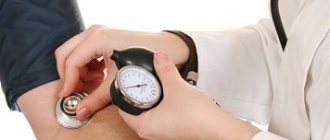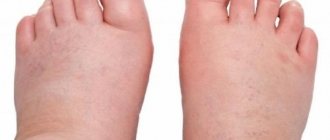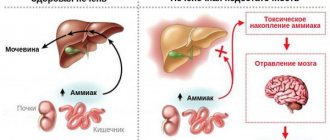Local therapist
Serebryakova
Oksana Evgenievna
Experience 27 years
Local therapist, candidate of medical sciences, member of the Russian Scientific Medical Society of Therapists
Make an appointment
The patient's condition is considered febrile if the body temperature rises above 37.2°C. This condition is not an independent disease, but is regarded as a sign of a serious pathology - an inflammatory process, infection, oncology. Less commonly, body temperature rises when taking certain medications and during heat stroke. Also, the temperature can fluctuate around the specified value during the day - decrease at night during sleep and increase in the evening due to intense exercise. For a healthy person, the range of daily fluctuations usually does not exceed 0.6°C.
Classification of fever
Depending on the level of body temperature, the following method of classifying fever is used:
- subfebrile temperature within 37.2 - 37.9°);
- febrile temperature at 38.0 – 38.9°C;
- pyretic temperature at 39.0 – 40.9 °C;
- hyperpyretic temperature starts at 41°C.
Attempts to cope with the rise in temperature are selected depending on its level. For low-grade fever, intervention is not recommended. The exception is pathology, when even a slight increase in temperature causes significant inconvenience to the patient. As the parameter increases, measures must be taken to stabilize it. Moreover, in the overwhelming majority of cases, the symptoms of fever indicate a serious problem in the body, to which it reacts by attempting to destroy the cause through high temperature or defeat it through the production of antibodies. Even if the temperature has been reduced, it is necessary to seek medical help and undergo the recommended diagnostics to clarify the cause of the fever and the immune response.
Basic information about the pathological symptom
What is typical for hectic fever? Until recently, people classified this pathological condition as a disease characterized by a significant increase in body temperature. However, modern medicine classifies it not as a separate disease, but as a peculiar reaction to various irritants, which are certain pyrogenic substances.
Thus, we can safely say that hectic fever is a pathological process that is aimed at protecting and adapting the body. It should be especially noted that without medical control, this condition poses a rather serious threat to the patient’s life.
Symptoms
With a slight increase in temperature, a person does not feel any discomfort and continues to lead his usual lifestyle. Rarely, there may be a feeling of discomfort due to temperature differences and a feeling of heaviness in the head area. When the temperature rises to 38.0 °C or more, characteristic “feverish” symptoms appear:
- redness of the skin of the face and body;
- inflamed eyes, caused by increased tear production;
- intense sweating associated with the body’s attempt to reduce the increased temperature;
- headache;
- aches in muscles and joints;
- decreased appetite;
- rapid breathing;
- drowsiness, immobility.
Children may experience a different course of the febrile process. “Red” fever is characterized by a slight deterioration in the condition, maintaining a comfortable temperature of the extremities and relatively stable health. With “white” fever, the child becomes lethargic, his skin turns pale and acquires a bluish tint, the pulse becomes faster, and blood pressure is higher.
Publications in the media
Fever of unknown origin (FOU) is an increase in body temperature >38.3 °C for >3 weeks without identifying the cause after a 1-week intensive diagnostic search.
Etiology • Infectious diseases . Any infection can be accompanied by fever, but difficulties in diagnosis are often caused by sporadic, uncharacteristic or atypical diseases. Anamnesis, including epidemiological, is important.
•• Bacterial infections ••• Abdominal abscesses (subphrenic, retroperitoneal, pelvic), the likelihood of which increases with a history of trauma, surgery, gynecological or laparoscopic manipulations ••• Tuberculosis is one of the common causes of LNG. Diagnosis is difficult in cases of extrapulmonary tuberculosis with negative tuberculin tests. An important role in diagnosis is assigned to the search for lymph nodes and their biopsy ••• Infectious endocarditis is difficult to diagnose in cases of absence of heart murmurs or negative bacteriological blood cultures (usually due to previous antibiotic therapy) ••• Empyema of the gallbladder or cholangitis in elderly patients may occur without local symptoms of tension in the right upper quadrant of the abdomen ••• Osteomyelitis can be suspected in the presence of local tenderness in the bones, but radiographic changes may not be detected until several weeks later ••• Meningeal or, especially, gonococcal sepsis can be suspected by the presence of a characteristic rash; confirmed by bacteriological blood culture data ••• When identifying hospital-acquired LNG, the structure of hospital-acquired infections in a particular medical institution should be taken into account; the most common etiological agents are Pseudomonas aeruginosa and staphylococci.
•• Viral infections ••• Fever in AIDS is caused in 80% by concomitant infection, in 20% by lymphomas ••• Infection caused by the herpes virus, CMV, Epstein-Barr, is difficult to diagnose in the elderly (erased clinical manifestations); Serological confirmation of the presence of infection is important.
•• Fungal infections (candidiasis, fusarium, actinomycosis, histoplasmosis) are most likely in patients with AIDS and neutropenia.
•• Parasitic infections (malaria, toxoplasmosis, leishmaniasis) can be suspected in persons who have visited endemic areas.
• Neoplasms.
•• Hodgken and non-Hodgken lymphomas : diagnosis is difficult with retroperitoneal localization of lymph nodes •• Hemoblastoses •• Solid tumors (most typically with metastases to the liver or with tumor obstruction of the urinary tract).
• Systemic connective tissue diseases.
•• SLE: diagnosis is facilitated by the detection of ANAT •• Still's syndrome has no serological markers; is accompanied by the appearance of a salmon-colored rash at the height of fever (see Rheumatoid Arthritis) •• Among systemic vasculitis, the most common are polyarteritis nodosa and giant cell arteritis.
• Granulomatous diseases.
•• Sarcoidosis ( diagnosis is difficult with isolated liver damage or questionable changes in the lungs; liver biopsy or CT is important to clarify the condition of the bronchopulmonary lymph nodes) •• Crohn's disease is diagnostically difficult in the absence of diarrhea; endoscopy and biopsy data are important.
• Fever of medicinal origin (vaccines, antibiotics, various drugs): usually there are no skin manifestations of allergy or eosinophilia; drug withdrawal leads to normalization of body temperature within several days.
• Endocrine pathology.
•• Acute thyroiditis and thyrotoxicosis •• Adrenal insufficiency (rare) • Recurrent pulmonary embolism.
Pathogenesis. Exogenous pyrogens induce the production of cytokines (IL-1, IL-6, α-IFN, TNF-α). The effect of cytokines on the thermoregulatory centers of the hypothalamus leads to an increase in body temperature.
Classification • “Classical” variant of LNG (difficult to diagnose variants of diseases traditionally associated with fever) • Hospital LNG • LNG due to neutropenia • HIV-associated (mycobacteriosis, CMV infection, cryptococcosis, histoplasmosis).
Clinical picture • Increased body temperature • The type and nature of fever are usually not very informative • General symptoms accompanying increased body temperature are headache, general malaise, muscle pain. Diagnostic tactics • History •• In the history, not only current complaints are important, but also those that have already disappeared •• All previous diseases should be identified, including operations, injuries and mental disorders •• Details such as family history may also be significant , data on vaccination and medication, professional history, clarification of the travel route, information about the sexual partner, the presence of animals in the environment • Physical examination • At the very early stage of diagnosis, artificial causes of fever should be excluded (administration of pyrogens, manipulations with a thermometer) • Identification of the type of fever (intermittent, remitting, constant) allows one to suspect malaria by the characteristic periodicity of fever (on the 3rd or 4th day), but for other diseases it provides little information • Physical examination should be carried out carefully and regularly, focusing on the appearance or change in the nature of the rash , heart murmurs, lymph nodes, neurological manifestations, fundus symptoms.
Laboratory data • CBC •• Changes in leukocytes: leukocytosis (for purulent infections - shift of the leukocyte formula to the left, for viral infections - lymphocytosis), leukopenia and neutropenia (neutrophil content in peripheral blood <1.0109/l •• Anemia • • Thrombocytopenia or thrombocytosis •• Increased ESR. • OAM • It should be borne in mind that persistent leukocyturia with repeated negative results of bacteriological urine culture should alert you to renal tuberculosis. • Biochemical blood tests •• Increased concentration of CRP •• With an increase in the concentration of ALT, AST, it is necessary to conduct a targeted study for liver pathology •• Fibrinogen D-dimers - if PE is suspected. • Bacteriological blood culture. Several cultures of venous blood are carried out (no more than 6) for the presence of possible bacteremia or septicemia. • Bacteriological urine culture, if PE is suspected. renal tuberculosis - culture on media selective for mycobacteria • Bacteriological culture of sputum or stool - in the presence of appropriate clinical manifestations. • Bacterioscopy: examination of a “thick drop” of blood for Plasmodium malaria. • Immunological methods • Comprehensive examination of the patient for tuberculosis •• In anergic or acute infection, the tuberculin skin test is almost always negative (it should be repeated after 2 weeks). • Serological studies are carried out for infections caused by Epstein-Barr viruses, hepatitis, CMV, pathogens of syphilis, Lyme borreliosis, Q-fever, amoebiasis, coccidioidomycosis. Testing for HIV infection is mandatory! • Study of thyroid function in cases of suspected thyroiditis • Determination of RF and ANAT in cases of suspected systemic connective tissue diseases.
Instrumental data • X-ray of the chest, abdominal cavity, paranasal sinuses (according to clinical indications) • CT/MRI of the abdominal cavity and pelvis if an abscess or space-occupying lesion is suspected • Bone scanning with Tc99 in the early diagnosis of osteomyelitis has greater sensitivity than the x-ray method • Ultrasound of the abdominal cavity and pelvic organs (in combination with a biopsy if indicated) for suspected mass formation, obstructive kidney disease or pathology of the gallbladder and biliary tract • EchoCG for suspected heart valve damage, atrial myxoma, pericardial effusion • Colonoscopy for suspected disease Crohn's • ECG: possible signs of overload of the right heart with PE • Bone marrow puncture if hemoblastosis is suspected, to identify the causes of neutropenia • Liver biopsy if granulomatous hepatitis is suspected • Temporal artery biopsy if giant cell arteritis is suspected • Biopsy of lymph nodes, altered muscle areas and/or skin.
Features in children. The most common causes of LNG are infectious processes and systemic connective tissue diseases.
Features in the elderly. The most likely causes are cancer, infections (including tuberculosis), systemic connective tissue diseases (especially polymyalgia rheumatica and arteritis of the temporal artery). Signs and symptoms are less severe. Concomitant diseases and the use of various drugs can mask fever. The mortality rate is higher than in other age groups.
Features in pregnant women. An increase in body temperature increases the risk of developing neural tube defects in the fetus and causes premature birth.
TREATMENT General tactics • It is necessary to establish the cause of fever using all possible methods; until the cause is established, symptomatic treatment • Caution should be given against “empirical therapy” of GC, which can be harmful if the fever is infectious in nature. Mode. Hospitalization of the patient, limiting contacts until infectious pathology is excluded. Patients with neutropenia are placed in boxes. Diet • When body temperature rises, increase the amount of fluid consumed • Patients with neutropenia are prohibited from bringing flowers (source of Pseudomonas aeruginosa), bananas (source of Fusarium), lemons (source of Candida) into the ward.
Drug treatment Treatment is prescribed depending on the underlying disease. If the cause of fever is not established (in 20%), the following drugs can be prescribed. • Antipyretics: paracetamol or NSAIDs (indomethacin 150 mg/day or naproxen 0.4 g/day). • Tactics of empirical therapy for LNG due to neutropenia •• Stage I: start with penicillin, which has activity against Pseudomonas aeruginosa (azlocillin 2-4 g 3-4 times / day) in combination with gentamicin 1.5-2 mg/ kg every 8 hours or with ceftazidime 2 g IV every 8 or 12 hours •• Stage II: if fever persists, on the 3rd day an antibiotic acting on gram-positive flora is added (cefazolin 1 g IV every 6–8 h, if ceftazidime has not been previously prescribed) •• Stage III: if the fever persists for another 3 days, amphotericin B 0.7 mg/kg/day or flunicazole 200–400 mg/day IV should be added •• If the fever is eliminated, An effective antibiotic regimen is continued until the neutrophil count returns to normal.
Course and Prognosis • Depends on etiology and age • One-year survival rates are: 91% for those under 35 years of age, 82% for those aged 35–64 years and 67% for those over 64 years of age. Abbreviations. FNG is a fever of unknown origin.
ICD-10 • R50 Fever of unknown origin
Diagnostics
You can check your body temperature by measuring it with a mercury or electronic medical thermometer. It is placed in the armpit so that the shoulder fits tightly to the chest and a sealed space is maintained inside the armpit. In children and weakened patients, the hand with the thermometer should be held. The measurement duration is about 10 minutes. When assessing the actual indicator, you should focus on the level of 36.4-37.2 ° C - a temperature in the specified range is considered normal.
When measuring temperature in young children, use a special rectal thermometer designed to measure body temperature through the anus. However, this method has several contraindications. These are anal fissures, pronounced hemorrhoids and inflammation of the rectum, which excludes any additional trauma to the mucous membrane. The measurement is taken with the patient positioned on his side, with his knees pressed to his chest. The thermometer is inserted into the anus so that the measuring tip goes completely inside. To obtain the desired parameter, 2-3 minutes are enough, and the range of 37.1–37.9 ° C is considered normal.
An oral method of measuring temperature, for which a safe electronic thermometer is used, is considered acceptable. The normal variant here is the range of 36.7 -37.4°C. However, the data may be distorted due to the patient's recent consumption of hot or cold foods and drinks.
Establishing the fact of a febrile state is only part of the diagnostic measures. The doctor needs to find out what caused the increase in body temperature. For a more precise diagnosis of fever, the patient is referred to:
- radiography;
- ultrasonography;
- blood and urine tests;
- other diagnostic procedures.
Origin and list of diseases
Hectic fever is characteristic of many ailments. Before listing them, it is necessary to identify why such a condition occurs in the first place.
As is known, hyperthermia is a polyetiological secondary condition. The process of restructuring in the work of the thermoregulation center begins with the activity of certain pyrogenic substances in the body. Moreover, the latter are divided into exogenous, or infectious, and non-infectious, that is, endogenous.
So why does hectic fever develop?
What diseases does it occur in? This pathological condition can develop for 2 different reasons. Let's look at them right now:
- An infectious process manifested in the form of inflammatory diseases. These include tuberculosis, influenza, sepsis of the blood, as well as internal organs.
- Non-infectious origin. This condition can cause tissue necrosis, oncology, allergies, blood transfusions and internal hemorrhages.
Treatment options for fever
Stabilization of body temperature and treatment of fever is carried out using the following methods:
- Taking antipyretic medications. This could be paracetamol, aspirin (contraindicated in children under 12 years of age), ibuprofen tablets or syrup. The advantages of the liquid composition are the possibility of its precise dosage and ease of swallowing, which is especially important for children. It is possible to take powders containing the listed antipyretic substances, which simultaneously have an analgesic and anti-inflammatory effect.
- Compliance with bed rest, due to which the patient’s condition improves somewhat.
- Reviewing your diet in favor of frequent small meals. Priority is given to dishes with a liquid or puree consistency, the digestion of which causes the body to spend less energy. You should completely exclude the use of hot and spicy dishes, seasonings and salty foods that draw water from the body.
- Drink plenty of fluids to prevent dehydration.
- Taking medications to treat the underlying cause of the fever. These could be antibiotics, non-steroidal anti-inflammatory drugs, etc.
If the temperature rises after heat stroke, measures should be taken to reduce it. For this, the patient is wiped with cool water, given plenty of clean water to drink, covered with ice packs and wrapped in wraps.
Types of febrile reactions depending on the degree of increase in body temperature
| Type of fever | Temperature fluctuations |
| low-grade fever | 37.2 – 38.00С |
| febrile | 38.1 – 39.00С |
| pyretic | 39.1 – 40.00С |
| hyperpyretic | above 40.0 0С |
Only some diseases manifest themselves with characteristic, pronounced temperature curves; however, it is important to know their types for differential diagnosis. It is not always possible to accurately correlate typical changes with the onset of the disease, especially with early antibiotic therapy. However, in some cases, the nature of the onset of fever can suggest a diagnosis. Thus, a sudden onset is characteristic of influenza, meningitis, malaria, subacute (2-3 days) - for typhus, psittacosis, Q fever, gradual - typhoid fever, brucellosis.
Diagnosis and treatment of fever at the clinic of JSC "Medicine" in Moscow
If signs of fever persist for several days without other visible symptoms, it is recommended to stop self-medicating and seek medical help. You can get it at the clinic of JSC "Medicine" in the Central Administrative District of Moscow, which has its own diagnostic center and outpatient clinic for undergoing prescribed procedures. Patients of the clinic invariably receive attentive attention, the opportunity to save time and money on undergoing research, as well as a guarantee of the security and confidentiality of personal information. Appointments can be made by phone or on the center's website.
Treatment
Treatment of fever should serve two purposes. Maintaining the functioning of internal organs, especially the respiratory, cardiac and excretory systems. And also to combat hyperthermia. For this purpose, not only medications can be used, but also physical effects on the body.
The patient is removed from his clothes and goes to bed with his head slightly raised. The head and wrists are covered with cold compresses from soaked bandages or ice packs. The body is wiped with a 3% solution of vinegar, alcohol or just cool water. Additionally, you can use a blower fan or air conditioner.
The patient may undergo gastric lavage and water enemas, just as the patient would. All intravenous infusion solutions are also stored in the refrigerator. At this stage, it is important that the body temperature reaches a maximum of 37.5 °C, as the body itself will continue to decline under the influence of the above measures.
Prescribed medications include antipyretics and antiallergic drugs in the form of intramuscular injections. These may be brufen and its analogues, solutions of acetylsalicylic acid and analgin with diphenhydramine or suprastin. Aminazine or lytic compounds are recommended for hyperactivity.
Resuscitation is performed in case of respiratory failure or cardiac arrest. If there is a threat of cerebral edema, magnesium sulfate is used. Prednisolone is used for hypotension and seduction to control attacks.









